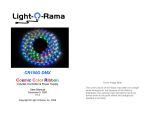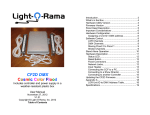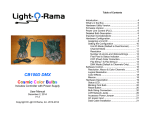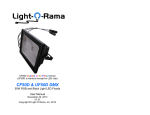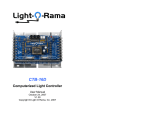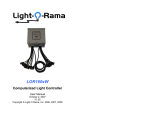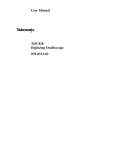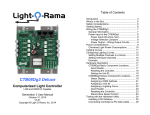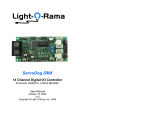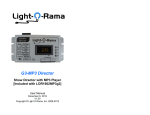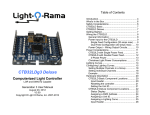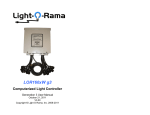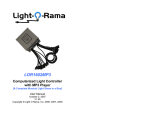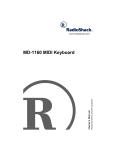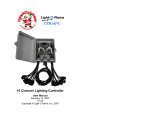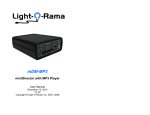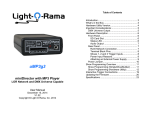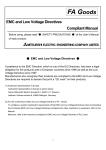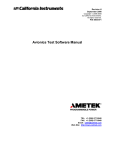Download DIO32 Manual - Light-O-Rama
Transcript
DIO32 DMX 32 Channel Digital I/O Controller Daughter Boards: DIO16AC – 16 Channel Dimmer DIO8RLY – 8 Channel Relay DIO8ACF – 8 Channel Dimmer DIO16IOS – 16 Channel Connector User Manual September 23, 2009 V1.0 Copyright © Light O Rama, Inc. 2008, 2009 Powering with 12 vdc ......................................... 27 Powering with 15 to 36 vdc ................................ 27 Servo Control Connectors (24 Pin) .................... 28 Sequence Editor Channel to Servo Port ............ 29 Servo Power Connection ................................... 30 Status LED1....................................................... 30 Status LED2....................................................... 30 Unit ID Switches................................................. 30 Zero-Cross Selection ......................................... 31 How to Connect Input Switches............................. 33 Stand Alone Operation .......................................... 34 Daughter Boards ................................................... 35 DIO8ACF 120/240 vac, High Current, Filtered 8Channel Triac Dimming ..................................... 36 DIO8ACF Specifications................................. 36 Connecting the DIO8ACF to the DIO32 ......... 36 DIO8ACF Power Connections........................ 37 DIO16AC 12/24/120/240 vac, 16-Channel Triac Dimming............................................................. 37 DIO16AC Specifications ................................. 38 Connecting the DIO16AC to the DIO32.......... 38 DIO16AC Power Connections ........................ 38 DIO8RLY 8-Channel Relay ................................ 39 DIO8RLY Specifications ................................. 39 Connecting the DIO8RLY to the DIO32.......... 40 DIO8RLY Power Connections ........................ 40 DIO16IOD 16-Channel Connection Board ......... 40 DIO16IOs Specifications ................................ 40 Connecting the DIO16IOS to the DIO32 ........ 41 DIO16IOS Input/Output Connections ............. 41 Updating the DIO32 Firmware ............................... 41 Appendix A Hexadecimal to Decimal..................... 44 Appendix B LOR Unit ID to DMX Address ............. 46 Specifications ........................................................ 47 Table of Contents Introduction.............................................................. 5 What’s in the Box..................................................... 6 Important Considerations ........................................ 6 Hardware Utility Version .......................................... 6 Port Capabilities ...................................................... 7 Software Control...................................................... 7 Digital Input Ports................................................. 8 Digital Output Ports.............................................. 8 Dimming Output Ports.......................................... 8 Servo Output Ports .............................................. 8 Hardware Utility Configuration of Ports ................ 9 Setting Input NO/NC Selection ....................... 10 Setting Servo Pulse width ranges................... 11 DMX Mode............................................................. 13 Hardware Description ............................................ 14 Hardware Configuration Checklist...................... 14 Fuses ................................................................. 15 JP6 Header ........................................................ 15 JP7 Header ........................................................ 16 Legacy Mode Jumper ........................................ 16 Network Connections ......................................... 17 Connecting to a PC ........................................ 17 Connecting to a Show Director....................... 18 Connecting to another Controller.................... 19 Port DC Power Jumpers .................................... 20 Port 16-Pin Connectors...................................... 21 Unit ID to Sequence Editor Channel .................. 22 Port IO Select DIP Switches .............................. 24 Powering with 120 vac ....................................... 25 Powering with 240 vac ....................................... 25 Powering with 12 vac ......................................... 26 Powering with 24 vac ......................................... 26 97H 30H 98H 31H 9H 10H 3H 10H 34H 102H 35H 103H 36H 104H 37H 105H 38H 106H 39H 107H 40H 108H 41H 109H 42H 10H 43H 1H 4H 12H 45H 13H 46H 14H 47H 15H 48H 16H 49H 17H 50H 18H 51H 19H 52H 120H 53H 12H 54H 12H 5H 123H 56H 124H 57H 125H 58H 126H 59H 127H 60H 128H 61H 129H 62H 130H 63H 13H 96H 29H 32H DIO32 DIO32 Introduction What’s in the Box The Light-O-Rama (LOR) DIO32 is a 32 channel digital controller that can be used in a LOR Network or in a DMX512 universe to perform digital output, dimming control and servo control. Digital input is also possible in a LOR network. It has four eight-bit ports. Each eight-bit port can be configured independently. The box contains a DIO32 Digital I/O Controller and this user manual. The latest manual is also available at www.lightorama.com ► Support ► DIO32 User’s Manual. There are four optional daughter boards that can be mixed and matched to create the controller required by your application. The daughter boards are: ***** WARNING ***** • • • • DIO8RLY – Eight channel relay board, each channel can handle 16 amps at 250 vac DIO8ACF – Eight channel, high power, 120/240 vac, 60 amp total, filtered triac dimming board DIO16AC – Sixteen channel, 12/24/120/240 vac, 60 amp total, triac dimming board DIO16IOS – Sixteen channel, screw terminal connection board The 32 I/O channels are fully buffered and each channel is capable of sourcing or sinking 24 ma at 5 vdc. The DIO32 may be used without any of the daughter boards depending upon your application. The Windows Showtime software is used to design and build Sequences (controller commands that may be choreographed to audio/music.) These user created sequences and/or pre-programmed musical sequences available from LOR are then arranged into Shows. These shows are played by your PC or one of the LOR Show Directors which command the controller(s). Page 5 Important Considerations In order to provide maximum flexibility, the DIO32 can use a variety of power sources. Be sure to consult the Hardware Description Checklist section before connecting power to the board. If all the power related jumpers are not properly configured, the board may be irreparably damaged. Hardware Utility Version The version of the Hardware Utility appears in the title bar to the right of “Light-O-Rama Hardware.” If the version number is less than 2.4.7, then you need a new Hardware Utility. The latest version is available for download at www.lightorama.com ► Support ► Software Downloads. Click the Download button to the left of the Hardware Utility and run the installer. Page 6 DIO32 Port Capabilities The four ports (A, B, C & D) are configured independently. An individual port (8 bits) can be all Digital Input, all Digital Output, all Dimming or all Servo Control. Note that only ports C & D have 3-pin servo connectors but all ports can be used for servo control. Software Control The DIO32 appears in a LOR Network at the address set by its Unit ID switches. Each 8-bit port appears as a set of 8 channels in the Sequence Editor. Port A is channels 1-8, Port B is 9-16, Port C is 17-24 and Port D is 25-32. The board also supports a “Legacy Mode” that causes the board to appear as two consecutive Unit IDs. The first ID is set by the Unit ID switches and represents Ports A & B. The second ID is at the Unit ID switches + 1 and represents Ports C & D. This allows the board to be used in environments where the maximum number of channels supported per controller is limited to 16. See the Legacy Mode Jumper section for more information. Since the individual ports can be configured to do different functions (digital input, digital output, dimming or servo control) the behavior in the Sequence Editor depends upon how a particular port is configured. Reading a port not configured for input returns a random result. An output command (intensity, Page 7 DIO32 shimmer, fade, etc.) to a port configured for input will be ignored. Digital Input Ports Digital input ports are used to sense user inputs, normally to provide for interaction in shows. See the How to Connect Input Switches section for information on connecting push-buttons or switches. Port A can also be used to start one internal stand alone animation sequence. See the Stand Alone Operation section for more information. Digital Output Ports A digital output port is ON for any intensity greater than zero, otherwise it is off. Shimmer will rapidly turn ON and OFF a digital output port. Twinkle will randomly turn ON and OFF a digital output port. Digital output ports are normally used to control relays. Dimming Output Ports These ports respond to Sequence Editor commands in the same way as a normal lighting controller. All effects are supported. Servo Output Ports These ports respond to Sequence Editor commands in the same was as a normal lighting controller. 0% intensity is fully left or counterclockwise (minimum pulse width), 50% intensity is centered and 100% intensity is fully right or clockwise (maximum pulse width.) Page 8 DIO32 DIO32 Servo pulses on a port do not start until the first command is received for that channel. If your sequence has all off at its start, then when the sequence starts the servo ports will start pulsing and go to the minimum pulse width (0% intensity.) Servo mechanical structures should be able to withstand servo position at minimum pulse width. Config Screen button on the lower left of the Servo Configuration screen. Servo pulses will stop when communication is lost to the controller and will restart when the first command is received for the channel corresponding to the servo port. Setting Input NO/NC Selection Note that shimmer and twinkle are not supported on servo ports. Hardware Utility Configuration of Ports Currently the DIO32 supports only Legacy mode which means that it appears as two consecutive unit IDs starting with the unit ID set by the on-board switches. The following screen capture shows the Digital IO Boards tab configuration screen for the first unit ID, ports A & B. If the Port Select DIP switches are set to off-on-on-on for one or both ports, then you can set the NO/NC parameter for the inputs using this screen. The Hardware Utility is used to configure the servo pulse width ranges. If the port’s selection switches are set to allow Hardware Utility configuration of inputs (refer to the Port IO Select DIP Switches section) then NO/NC can be set for each input bit individually. The Hardware Utility will read the setting of the Port Select DIP switches to determine how the ports are being used. To configure the DIO32, start the Hardware Utility and click the Digital IO Boards tab. You will see the Configuration screen. This screen allows you to configure the NO/NC option for input ports. To switch to the DIO32 – Servo Configuration screen, click the DIO32-Servo Screen button on the lower left of the window. You can return to the Configuration screen by clicking the Return to After setting the NO/NC parameter for the input ports, be sure to click the Send Info To Unit button so that the DIO32 will save these settings in its nonvolatile memory. Page 9 Page 10 DIO32 DIO32 The next screen capture shows the Digital IO Boards tab for the second unit ID: Setting Servo Pulse width ranges The following pulse width ranges can be selected: • • • • • • • • 1.25ms - 1.75ms 1.20ms - 1.80ms 1.10ms - 1.90ms 1.00ms - 2.00ms 0.90ms - 2.10ms 0.80ms - 2.14ms 0.70ms - 2.18ms 0.60ms - 2.20ms After setting the pulse widths for the servo ports using the drop down menus, be sure to click the Send Info To Unit button so that the DIO32 will save these settings in its non-volatile memory. The second unit ID, shown below, sets the pulse widths for servo ports C &D: The following screen capture shows the Hardware Utility’s Digital IO Boards tab after the DIO32-Servo Screen button has been clicked. Since the board is in Legacy mode, it shows up as two unit IDs. The first unit ID, shown below, sets the pulse widths for servo ports A & B: Page 11 Page 12 DIO32 DIO32 DMX Mode Hardware Description The DIO32 automatically recognizes DMX512 protocol if the unit ID switches are set according to Appendix B, LOR Unit ID to DMX Address. The controller occupies 32 DMX addresses. Refer to the following picture for the hardware description. The upright orientation is shown below. Note that the Light O Rama, Inc. silk-screening is upright, the network connection jacks are on the upper right and the 16-pin port connection headers are on the bottom. The DIO32 controller has RJ45 network connectors. You will need the LOR RJ-45 to XLR 3pin Male connector to connect the controller to a DMX universe. It is available from the Web Store on the accessories page: http://store.lightorama.com/accessories.html After the first LOR controller, you can use Cat5e LAN cables to daisy chain additional DMX capable LOR controllers. Input is not possible in DMX mode so ports configured for input will not be useable. For digital output ports, a DMX intensity of 0 turns the port off (0 vdc) any non-zero DMX intensity will turn the output port on (+5 vdc.) If the Port Select DIP Switches select inverted output, the output voltages are reversed. For dimmer ports, the triac/SSR duty cycle will be linearly set by the DMX intensity. For servo ports, DMX intensity 0 is minimum pulse width (fully counterclockwise,) intensity 128 is median pulse width (centered) and 255 is maximum pulse width (fully clockwise.) For more detailed information on DMX use of LOR controllers see: http://lightorama.com/Documents/DMX-DOC.pdf Page 13 Hardware Configuration Checklist ***** WARNING ***** Each of the following steps must be completed before powering up the DIO32. If all the power related jumpers are not properly configured, the board may be irreparably damaged. 1. The board must be powered down when making any changes to switches or jumpers. 2. See the Legacy Mode section for information on making this board appear as two consecutive 16 channel controllers. Page 14 DIO32 3. Choose one of the Powering with xxx sections below and set the jumpers for your power source. 4. Refer to the Port IO Select DIP Switches section to set the desired function for Ports A, B, C & D. 5. Refer to the Port DC Power Jumpers section to connect the on-board DC power supplies to the 16 pin port connectors. 6. If you are using any ports for servo control, refer to the Servo Power Connection and Servo Control 24 Pin Connectors sections. 7. If you are using any ports for triac dimming control, refer to the Zero-Cross Selection section. Fuses DIO32 JP7 Header This header is reserved for future expansion. No connections should be made to this header. Legacy Mode Jumper Note: Only legacy mode is supposed at this time and the jumper described below is not used. In Legacy Mode, the DIO32 appears as two 16 channel controllers. The Unit ID switches set the address of the first controller. The second controller is at the address of the Unit ID switches + 1. If this jumper is not present, then the controller operates in normal mode, meaning it has one Unit ID with 32 channels. In Legacy Mode, ports A & B appear on the first controller ID with Port A being channels 1 to 8 and Port B being channels 9 to 16. Ports C & D appear on the second controller ID with Port C being channels 1 to 8 and Port D being channels 9 to 16. To activate Legacy Mode, place a plastic jumper block on the 2nd vertical set or pins from the right on jumper header JP8. See picture below: F1 – This is a 1 amp 250 vac fuse used in the line voltage power supply. This fuse is required when running the DIO32 from 120 or 240 vac. F2 – This is a 2 amp 32 vac fuse used in the low voltage power supply section of the DIO32. This fuse is always required for operation. JP6 Header No connections should be made to this header. Page 15 Page 16 DIO32 Network Connections In order to use your DIO32, you must connect it to a Windows PC, a LOR Show Director or run it in stand alone mode (see the Stand Alone Operation section for more information.) The following picture labels the LOR network connectors: Connecting to a PC You will need the following to connect your DIO32 controller to a PC: • Showtime Windows Software • RS485 Adapter • CAT5e LAN cable or phone cable • Your DIO32 controller • Windows PC running 98 SE, 2000, ME, XP or Vista The first three items are available in the LOR SPKST Generic Starter Package. www.lightorama.com ► Web Store ► Showtime Products. You will have to choose an RS485 adapter type. It’s best to go Page 17 DIO32 with the USB485 if you have no intention of going wireless from your PC to the controller. If wireless is desired, get the USB485B. The following diagram shows how the pieces fit together: 1. Your PC running the Showtime Windows Software 2. Your PC speakers to play the music 3. RS485 Adapter to convert short distance USB to long distance RS485 4. Phone or CAT5e LAN cable 5. DIO32 controller in your enclosure If your USB adapter has more than one jack, you can use either. If you are using phone cable to connect the RS485 adapter to your controller, make sure you use the smaller “Phone In” jack on the DIO32. If you are using CAT5e LAN cable, you can use either of the larger jacks on the controller. Connecting to a Show Director You will need the following to connect your DIO32 controller to a Show Director: Page 18 DIO32 • • • LOR1602MP3 Show-in-a-Box controller (has an internal DC-MP3 Show Director), mDMMP3 Show Director or DC-MP3 Show Director Phone or CAT5e LAN cable Your DIO32 controller If you are using phone cable to connect a show director to the DIO32, you can use either jack on the show director. Make sure you use the smaller “Phone Cable In” jack on the DIO32. If you are using CAT5e LAN cable, you can use either jack on the show director and either of the large jacks on the DIO32. The cable connecting a show director to the controller should be 50’ or less in length. Longer cables may result in a voltage drop causing erratic operation of the show director. This 50’ limitation does not apply to the Show Director internal to the LOR1602MP3. It gets its power for the co-housed controller. Connecting to another Controller If you are using phone cable to connect two controllers together, always go from either of the large jacks on one controller to the smaller “Phone In” jack on other controller. DIO32 Port DC Power Jumpers These jumpers allow the on-board 5 and 12 vdc power supplies to be connected through to the 16pin port headers. These connections are required by some of the LOR daughter boards available for use for this controller. The total draw on the 5 vdc power must be kept under 1 amp. Likewise, the total draw on the 12 vdc power supply must be kept under 1 amp. Both the 5 and 12 volt supplies may draw their 1 amp simultaneously. For example, if you place a vertical jumper on the right two pins of JP3, then the 5 vdc supply will appear on pin 9 of the port A 16-pin header. See the Port 16-Pin Connectors section for more information. If you are using CAT5e LAN cable, you can go from either large jack on one controller to either large jack on the other controller. Page 19 Page 20 DIO32 Port 16-Pin Connectors The next diagram shows one of the four 16-pin port headers. DIO32 Unit ID to Sequence Editor Channel The Following table shows the mapping of I/O channels described above to Sequence Editor channels: Port, I/O channel 1. 2. 3. 4. 5. 6. 7. 8. 9. 10. 11. 12. 13. 14. 15. 16. I/O channel 5 I/O channel 1 I/O channel 6 I/O channel 2 I/O channel 7 I/O channel 3 I/O channel 8 I/O channel 4 5 vdc (optional, see the Port DC Power Jumpers section) Ground Zero-Cross input (optional, see the ZeroCross Selection section) 12 vdc (optional, see the Port DC Power Jumpers section) Reserved, do not use Reserved, do not use Reserved, do not use Reserved, do not use Page 21 Normal Mode Legacy Mode A, 1 Unit ID, Chan 1 Unit ID, Chan 1 A, 2 Unit ID, Chan 2 Unit ID, Chan 2 A, 3 Unit ID, Chan 3 Unit ID, Chan 3 A, 4 Unit ID, Chan 4 Unit ID, Chan 4 A, 5 Unit ID, Chan 5 Unit ID, Chan 5 A, 6 Unit ID, Chan 6 Unit ID, Chan 6 A, 7 Unit ID, Chan 7 Unit ID, Chan 7 A, 8 Unit ID, Chan 8 Unit ID, Chan 8 B, 1 Unit ID, Chan 9 Unit ID, Chan 9 B, 2 Unit ID, Chan 10 Unit ID, Chan 10 B, 3 Unit ID, Chan 11 Unit ID, Chan 11 B, 4 Unit ID, Chan 12 Unit ID, Chan 12 B, 5 Unit ID, Chan 13 Unit ID, Chan 13 B, 6 Unit ID, Chan 14 Unit ID, Chan 14 B, 7 Unit ID, Chan 15 Unit ID, Chan 15 B, 8 Unit ID, Chan 16 Unit ID, Chan 16 C, 1 Unit ID, Chan 17 Unit ID+1, Chan 1 C, 2 Unit ID, Chan 18 Unit ID+1, Chan 2 C, 3 Unit ID, Chan 19 Unit ID+1, Chan 3 C, 4 Unit ID, Chan 20 Unit ID+1, Chan 4 Page 22 DIO32 DIO32 C, 5 Unit ID, Chan 21 Unit ID+1, Chan 5 Port IO Select DIP Switches C, 6 Unit ID, Chan 22 Unit ID+1, Chan 6 C, 7 Unit ID, Chan 23 Unit ID+1, Chan 7 C, 8 Unit ID, Chan 24 Unit ID+1, Chan 8 The following table shows the affect of setting a Port’s Select DIP Switch to various values. There is one DIP switch for each 8-bit port. The ports are configured independently. D, 1 Unit ID, Chan 25 Unit ID+1, Chan 9 D, 2 Unit ID, Chan 26 Unit ID+1, Chan 10 DIP Switch Function D, 3 Unit ID, Chan 27 Unit ID+1, Chan 11 off-off-off-off Digital Input – NO switch D, 4 Unit ID, Chan 28 Unit ID+1, Chan 12 off-off-off-on Digital Input – NC switch D, 5 Unit ID, Chan 29 Unit ID+1, Chan 13 D, 6 Unit ID, Chan 30 Unit ID+1, Chan 14 off-off-on-off Digital Output D, 7 Unit ID, Chan 31 Unit ID+1, Chan 15 off-off-on-on Digital Output (inverted) D, 8 Unit ID, Chan 32 Unit ID+1, Chan 16 off-on-off-off Dimming, use port A zero cross off-on-off-on Dimming, use zero cross from individual port off-on-on-off Servo control off-on-on-on Digital Input – Hardware Utility sets NO/NC NO means Normally Open – meaning that the channel will read as ON if there is +5 vdc present at the header pin. NC means Normally Closed so the channel reads as ON when 0 vdc is present at the header pin. Page 23 Page 24 DIO32 Powering with 120 vac Referring to the following picture: DIO32 • • • • • JP10 – jumper on bottom two pins JP11 – no jumpers JP14 – jumper on top two pins JP15 – Jumper on top two pins 240 vac power to terminals AC1 & AC2 Powering with 12 vac Referring to the following picture: • • • • • • JP1 – two jumpers, side by side JP10 – jumper on top two pins JP11 – no jumpers JP14 – jumper on top two pins JP15 – Jumper on top two pins 120 vac power to terminals AC1 & AC2 Powering with 240 vac Referring to the following picture: • • • • • • JP1 – no jumpers JP10 – no jumpers JP11 – jumper on bottom two pins JP14 – jumper on bottom two pins JP15 – Jumper on bottom two pins 12 vac power to screw terminals X1 Powering with 24 vac Referring to the following picture: • JP1 – one jumper on center two pins Page 25 Page 26 DIO32 • • • • • • DIO32 JP1 – no jumpers JP10 – no jumpers JP11 – jumper on top two pins JP14 – jumper on bottom two pins JP15 – Jumper on bottom two pins 24 vac power to screw terminals X1 Powering with 12 vdc Referring to the following picture: • • • • • • JP1 – no jumpers JP10 – no jumpers JP11 – no jumpers JP14 – no jumpers JP15 – no jumpers 15 to 36 vdc power to screw terminals X1, right screw terminal is positive Note: on board zero-cross detector is disabled when using DC power • • • • • • JP1 – no jumpers JP10 – no jumpers JP11 – no jumpers JP14 – no jumpers JP15 – no jumpers 12 vdc (± 0.5 volts) power to barrel jack JK1, center pin positive Servo Control Connectors (24 Pin) Ports C & D may be used to control servos. DC Servo power must be supplied to the screw terminals to the right of the servo connection headers. See the next section for more info on servo power. Note: on board zero-cross detector is disabled when using DC power. Powering with 15 to 36 vdc Servo Connectors Port C Port D Referring to the following picture: Page 27 Page 28 Servo Power Input + on bottom DIO32 On the servo connection headers, the top row of pins is the servo control pulse outputs. The middle row is positive power and the bottom row is ground. Sequence Editor Channel to Servo Port The following table shows the Sequence Editor Channel number to servo port connection: DIO32 Servo Power Connection Due to the voltage and current requirements of servos, the on-board power supplies cannot be used to power servo actuators. DC servo power must be brought into the board using screw terminals X2 located on the lower right edge of the board. Status LED1 Port and Servo # Normal Mode Legacy Mode C, 1 Unit ID, Chan 17 Unit ID+1, Chan 1 C, 2 Unit ID, Chan 18 Unit ID+1, Chan 2 C, 3 Unit ID, Chan 19 Unit ID+1, Chan 3 C, 4 Unit ID, Chan 20 Unit ID+1, Chan 4 C, 5 Unit ID, Chan 21 Unit ID+1, Chan 5 C, 6 Unit ID, Chan 22 Unit ID+1, Chan 6 C, 7 Unit ID, Chan 23 Unit ID+1, Chan 7 C, 8 Unit ID, Chan 24 Unit ID+1, Chan 8 Status LED2 D, 1 Unit ID, Chan 25 Unit ID+1, Chan 9 Reserved for future use. D, 2 Unit ID, Chan 26 Unit ID+1, Chan 10 D, 3 Unit ID, Chan 27 Unit ID+1, Chan 11 D, 4 Unit ID, Chan 28 Unit ID+1, Chan 12 D, 5 Unit ID, Chan 29 Unit ID+1, Chan 13 D, 6 Unit ID, Chan 30 Unit ID+1, Chan 14 D, 7 Unit ID, Chan 31 Unit ID+1, Chan 15 D, 8 Unit ID, Chan 32 Unit ID+1, Chan 16 Page 29 • Blinks twice per second if the DIO32 has booted correctly • Solid on if the DIO32 sees a network director – either a PC or Show Director • Blinks one long on and a short off repeatedly if in the bootloader. This means that the firmware is not loaded or corrupted. See the Updating the DIO32 Firmware section to load firmware Unit ID Switches Each LOR controller used in a network must have a Unit ID assigned. [If two controllers are given the same unit ID, then they will both perform the same effects.] Every channel that you control in a sequence (a sequence is a set of controller commands constructed using the Showtime Windows software) has to identify a particular output circuit (or channel) on a particular controller (Unit.) Page 30 DIO32 For example, in a sequence that you construct, a channel you call “Front door” may be assigned to Unit ID 03 circuit 10. Because the controllers are daisy chained together, every controller sees every command sent but only Unit 03 will react to commands that are marked “for Unit 03.” The two hexadecimal rotary dip switches (shown in the next picture) are used to set a controller’s Unit ID. Valid Unit ID values are 01 to F0 hex(1 to 240 decimal.) 00 is not a valid Unit ID. DIO32 selections (jumper JP10 and jumper JP11) for the zero-cross detectors are set when the AC power source is set. See the appropriate Power From xxx section. It is also possible to have the DIO32 determine the zero-cross from a signal received on the 16-pin port headers. This allows the DIO32 to perform dimming where the zero-crosses are different due to 3-phase power. The zero-cross signal is a 5 vdc signal that pulses positive at the zero-cross point. The setting of the Port IO Select DIP Switches determines the zero-cross source for a port. See the Port IO Select DIP Switches section for more information. To set the Unit ID to ’01,’ the left rotary switch would be set to ‘0’ and the right rotary switch would be set to ‘1.’ See Appendix A for a conversion of Hexadecimal controller unit IDs set with the switches and their decimal equivalents. Port A zero-cross is a special case. Jumper JP9 is used to select the zero-cross source for port A. The options are: • Get zero-cross from the 16-pin port A header “PORT A” • Get the zero-cross from the low voltage AC detector (12 or 24 vac) “LVAC” • Get the zero-cross from the high voltage AC detector (120 or 240 vac) “HVAC” This jumper, shown in the next picture, is located just below the large transformer. Place a vertical jumper on a column of two pins on the jumper shown below to make the selection. Zero-Cross Selection Zero-cross detection is required for dimming control using triacs or random-cross SSRs (Solid State Relays.) The DIO32 has the ability to detect zerocross on any of its AC input voltages. The jumper Page 31 Page 32 DIO32 DIO32 SW3 is a normally closed (NC) switch that breaks the circuit when pressed. When a port is used as digital inputs to control a show, all switches on that port must be either NC or NO. If the DIO32 port used is port A, then SW1 would be channel 1, SW2 would be channel 2 and SW3 would be channel 3. Note that the firmware in the controller is coded to work with the zero-cross detectors designed by Light O Rama. A foreign zero-cross detector may not present the zero-cross signal at exactly the same time as a LOR detector. If the foreign detector is not different by much you may notice incorrect dimming near the very dim and very bright settings. If it is significantly different, behavior may appear erratic, even with full on/off commands. How to Connect Input Switches The following diagram shows how to connect a few push button (momentary contact) switches to a digital input port 16-pin header. Since the ports can be input or output, they are floating and the 4.7K Ω resistor is required to set the port state. Stand Alone Operation A stand alone animation sequence (sequence with no accompanying audio) can be downloaded into the flash memory of the DIO32 controller. This sequence can contain approximately 5,000 commands. These commands can also be for controllers other than this controller, so this controller can direct a network of controllers. There are no restrictions on the types of LOR controllers in this network. The sequence is designed and tested using the Showtime Software Sequence Editor. When you are happy with the sequence, save it and stop the Sequence Editor. Start the Hardware Utility and click the Refresh button to find the DIO32. Use the drop down menu next to the Refresh button to select the controller. SW1 and SW2 are normally open (NO) switches, meaning they complete the circuit when pressed. Page 33 Click the Standalone button at the bottom of the window. Note that the trigger conditions set by the Hardware Utility in the stand-alone window are ignored. Page 34 DIO32 If you are using a switch to activate a sequence, then Port A on the controller must be configured for input. If port A is not configured for input, the sequence runs all the time. Port A, channel one starts the internal sequence according to the NO/NC rules set for this channel. See the Port IO Select DIP Switches section for more information. DIO32 DIO8ACF 120/240 vac, High Current, Filtered 8-Channel Triac Dimming Use the Open button to browse to your sequence and click the Download button. You also use this screen to remove downloaded standalone sequences. Note that all downloaded sequences are removed. You can also remove standalone sequences by turning the controller off, setting the Unit ID switches to ‘00’ and turning it on for 10 seconds. Then turn it off and reset the Unit ID switches to the original value. Daughter Boards This section describes the daughter boards that are available to extend the functionality of the DIO32. Daughter boards can be mixed and matched as needed using the 32 channels available. Available daughter boards: DIO8ACF – 8 channel filtered triac dimmer, 120/240 vac, up to 60 amps total DIO16AC – 16 channel triac dimmer, 12/24 or 120/240 vac, up to 60 amps total DIO8RLY – 8 channel SPDT relay, 16 amps @ 250 vac per relay DIO16IOS – 16 Channel Connector DIO8ACF Specifications • • • • • • • • Connecting the DIO8ACF to the DIO32 • Page 35 8½”w x 5¼”h x 2”d Eight 10 amp triac dimming channels Two banks of four channels 30 amps @ 120/240 vac per bank, 60 amps per board Both input power and output channels fully filtered with common mode chokes and capacitors Each bank and each channel separately fused Power limited to 20 amps per bank with supplied standard heat sinks Both power feeds must be on the same phase in three phase systems This device uses one 8-bit port on the DIO32 and appears as 8 channels. Page 36 DIO32 • • • Connect the DIO8ACF board to the DIO32 main board using one 16-line ribbon cable. Jumper through the 5 vdc power on the main board, see Port DC Power Jumpers section for more information Set the Port IO Select DIP Switch for dimming. See the Port IO Select DIP Switches for more information DIO32 DIO16AC Specifications • • • • • • DIO8ACF Power Connections The DIO8ACF has two 30 amp input screw terminal sets toward the bottom of the board. This board has only one zero-cross detector, therefore when it is used in a 3-phase environment, both power input terminal sets must be on the same phase. Power to the connected lighting is via ¼” blade terminals that run along the left and right edges of the board. DIO16AC 12/24/120/240 vac, 16-Channel Triac Dimming • 8½”w x 5¼”h x 1½”d Sixteen 8 amp triac dimming channels Two banks of eight channels 30 amps @ 12/24/120/240 vac per bank, 60 amps per board Each bank and each channel separately fused Power limited to 20 amps per bank with supplied standard heat sinks Each bank can be on a different phase in three phase systems Connecting the DIO16AC to the DIO32 • • • • This device can use one or two 8-bit ports on the DIO32 and appears as 8 or 16 channels. Connect the DIO16AC board to the DIO32 main board using one or two16-line ribbon cables. Jumper through the 5 vdc power on the main board for the DIO32 ports used, see the Port DC Power Jumpers section for more information Set the Port IO Select DIP Switches for dimming. See the Port IO Select DIP Switches section for more information DIO16AC Power Connections The DIO16AC has two 30 amp input screw terminal sets toward the bottom of the board. The left screw terminal set powers the left 8 channels and the right screw terminal set powers the right 8 channels. Page 37 Page 38 DIO32 This board contains two zero cross detectors so that the two input power terminal sets may be on different phases in 3-phase systems. Power to the connected lighting is via ¼” blade terminals that run along the left and right edges of the board. DIO8RLY 8-Channel Relay DIO32 Connecting the DIO8RLY to the DIO32 • This device uses on 8-bit port on the DIO32 and appears as 8 channels. • Connect the DIO8RLY board to the DIO32 main board using one 16-line ribbon cable. • Jumper through the 5 vdc and the 12 vdc power on the main board, see the Port DC Power Jumpers section for more information DIO8RLY Power Connections There are three ¼” blade connectors for each relay. One is a common connection and the others are the NO (normally open) and the NC (normally closed) contacts. Use ¼” female quick connects on your connection wires. DIO16IOD 16-Channel Connection Board DIO8RLY Specifications • • • • • • 8½”w x 5¼”h x 1½”d Eight Single Pole Double Throw (SPDT) relays Relay inputs and outputs are completely independent of one another, there is no common wiring Each relay is rated to handle 16 amps at 250 vac ¼” blade terminals for connection Each relay is separately fused DIO16IOs Specifications • Page 39 8½”w x 5¼”h x 1½”d Page 40 DIO32 • • 16 sets of screw terminals to facilitate connection of custom devices to the DIO32 main board Provided to eliminate the need to make a custom 16-pin ribbon cable to your device cable Connecting the DIO16IOS to the DIO32 • • Connect the DIO16IOS board to the DIO32 main board using one or two 16-line ribbon cables. Only connect one cable if you will only be using 8 of the 16 ports. Jumper through the 5 vdc power on the main board, see Port DC Power Jumpers section for more information. DIO16IOS Input/Output Connections • The ‘-‘ connections on the IOS board are a common ground. • The ‘+’ connections on the IOS board are the 0/5 vdc inputs/outputs depending upon the DIP configuration switch. See the Port IO Select DIP Switches section for more information. DIO32 Get the latest firmware. www.lightorama.com ► Support ► Using the Hardware – Documentation and Firmware section. Click the Firmware button in the DIO32 line and run the firmware installer program which will install the firmware file on your PC. Note the name of the firmware .lhx file. The normal location of firmware files is C:\Program Files\Light-O-Rama\Firmware. Start the LightORama Control Panel if it is not running by clicking start ► All Programs ► LightORama ► Light-O-Rama Control Panel. The Light-O-Rama light bulb icon will appear in the system tray on the lower right of your screen. Start the Hardware Utility by right-clicking the Light-O-Rama Control Panel light bulb and selecting Hardware Utility from the menu. Click the Firmware button in the LOR Control tab and you will see this window: Updating the DIO32 Firmware You must have: • • Hardware Utility version 2.0.16 or later, see the section Hardware Utility Version The DIO32 powered (see the Power … sections) and connected to the PC via one of the RS485 adapters – Do not use wireless Page 41 Page 42 DIO32 In Step 1 – Select Unit, choose the DIO32 radio button. In Step 2 – Select firmware file, click the Open button. Use the Open file box to select the firmware file. This is the .lhx file you saved in the Firmware folder. Click the Open button. The window will look like this: In Step 3 – Press Download Button, click the Download button – the firmware download will start automatically. The Update progress bar will fill from left to right. When the new firmware is loaded, the Status will change to “Successful” and the DIO32 will reboot. Page 43 DIO32 Appendix A Hexadecimal to Decimal Hex Hex Dec Hex Dec 01 01 Dec Hex 3D Dec 61 79 121 B5 181 02 02 3E 62 7A 122 B6 182 03 03 3F 63 7B 123 B7 183 04 04 40 64 7C 124 B8 184 05 05 41 65 7D 125 B9 185 06 06 42 66 7E 126 BA 186 07 07 43 67 7F 127 BB 187 08 08 44 68 80 128 BC 188 09 09 45 69 81 129 BD 189 0A 10 46 70 82 130 BE 190 0B 11 47 72 83 131 BF 191 0C 12 48 72 84 132 C0 192 0D 13 49 73 85 133 C1 193 0E 14 4A 74 86 134 C2 194 0F 15 4B 75 87 135 C3 195 10 16 4C 76 88 136 C4 196 11 17 4D 77 89 137 C5 197 12 18 4E 78 8A 138 C6 198 13 19 4F 79 8B 139 C7 199 14 20 50 80 8C 140 C8 200 15 21 51 81 8D 141 C9 201 16 22 52 82 8E 142 CA 202 17 23 53 83 9F 143 CB 203 18 24 54 84 90 144 CC 204 19 25 55 85 91 145 CD 205 1A 26 56 86 92 146 CE 206 1B 27 57 87 93 147 CF 207 1C 28 58 88 94 147 D0 208 1D 29 59 89 95 147 D1 209 Page 44 DIO32 1E 30 5A 90 96 150 D2 210 1F 31 5B 91 97 151 D3 211 20 32 5C 92 98 152 D4 212 21 33 5D 93 99 153 D5 213 22 34 5E 94 9A 154 D6 214 23 35 5F 95 9B 155 D7 215 24 36 60 96 9C 156 D8 216 25 37 61 97 9D 157 D9 217 26 38 62 98 9E 158 DA 218 27 39 63 99 9F 159 DB 219 28 40 64 100 A0 160 DC 220 29 41 65 101 A1 161 DD 221 2A 42 66 102 A2 162 DE 222 2B 43 67 103 A3 163 DF 2C 44 68 104 A4 164 2D 45 69 105 A5 2E 46 6A 106 2F 47 6B 30 48 6C 31 49 6D 109 A9 168 32 50 6E 110 AA 170 33 51 6F 111 AB 171 E7 231 34 52 70 112 AC 172 E8 35 53 71 113 AD 173 DIO32 Appendix B LOR Unit ID to DMX Address See the section Unit ID Switches for instructions on setting the controller’s unit ID. The controller must be set to one of the LOR Unit IDs listed in the following table to recognize DMX protocol. E.g. setting the LOR Unit ID to “06” will result in the first DMX address (base address) for the controller being 81. LOR DMX Unit ID Address LOR DMX Unit ID Address “01” 1 “11” 257 223 “02” 17 “12” 273 E0 224 “03” 33 “13” 289 165 E1 225 “04” 49 “14” 305 A6 166 E2 226 107 A7 167 E3 227 “05” 54 “15” 321 108 A8 168 E4 228 “06” 81 “16” 337 E5 229 “07” 97 “17” 353 E6 230 “08” 113 “18” 369 232 “09” 129 “19” 385 E9 233 “0A” 145 “1A” 401 36 54 72 114 AE 174 EA 234 “0B” 161 “1B” 417 37 55 73 115 AF 175 EB 235 38 56 74 116 B0 176 EC 236 “0C” 177 “1C” 433 39 57 75 117 B1 177 ED 237 “0D” 193 “1D” 449 3A 58 76 118 B2 178 EE 238 “0E” 209 “1E” 465 3B 59 77 119 B3 179 EF 239 3C 60 78 120 B4 180 F0 240 “0F” 225 “10” 241 “1F” 481 “20” 497 Page 45 Page 46 Specifications Dimensions 8½”w x 5¼”h x 2"d Channels 32 broken into four groups of 8 Source/Sink current for outputs 24 ma maximum Channel Input/Output Approximately 0 and 5 vdc voltages Maximum draw from on-board power supplies 1 amp total for all 4 ports from the 5 vdc and 1 amp total for all 4 ports from the 12 vdc. Both power supplies may be used simultaneously. Light-O-Rama, Inc. Tel: (518) 539-9000 Fax: (518) 538-0067 [email protected]
























